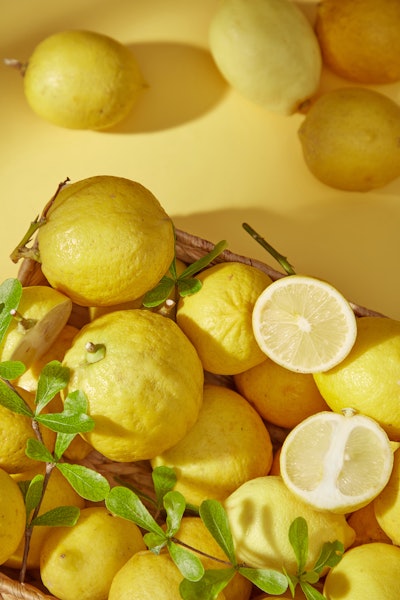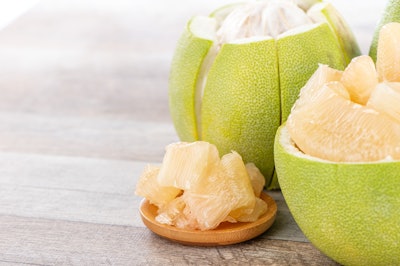
If data suggests anything it’s that people really like citrus products and profiles. I’m not naïve enough to suggest that everyone likes citrus products equally across the board but I’m pretty sure that most people love one form of citrus or another. I for one, am a citrus groupie. Mintel tells us that 67% of the United States population has tried and likes citrus profiles in desserts and confections. And if we look at TikTok, we see that #citrusfruit has gathered 4.8 million views and over 24,000 Instagram posts exist as well.
We also know that the orange oil industry in the United States will see its lowest production of oranges for the 2022/2023 season in over 80 years thanks to a combination of citrus greening, a January freeze and two hurricanes called Ian and Nicole. In Argentina, they are anticipating a reduced crop by 20% for lemons from the previous year. The lime crop from Mexico will also be lower in the 2022/2023 year due to lower yields from lack of rain and perhaps some cartel influence over workers and product.
So, what is a citrus devotee such as me to do? Well, we can cast our eyes upon some new citrus fruits that are at various stages of acceptance in the United States.
 While Yuzu can be confused as a lemon or lime, there is a noticeable difference in flavor profile.
While Yuzu can be confused as a lemon or lime, there is a noticeable difference in flavor profile.
Yuzu
Yuzu is a fine example of a fruit showing up in the adoption phase. It shows up on about 5% of menus across the United States. It was even featured in Better Homes and Gardens this year (wait, what??). Originally grown in China, production has migrated to Japan and Korea and has been prominent in their cuisines for hundreds of years. The Japanese typically use the rind as an addition to dishes, while Koreans will use Yuzu thinly sliced and craft a marmalade-type syrup for dishes or will use it in fruit punches. If you have tried Ponzu sauce, you have tried yuzu. Trader Joe's has a Yuzu ripple non-dairy frozen dessert that I would certainly vouch for.
While it can be confused with a lemon or lime, there is a noticeable difference in flavor profile. It’s often called out as being herbal and or floral or called a cross between lemon and grapefruit with even mandarins and oranges have been mentioned. Yuzu is heavy in terpenes as you might expect for a citrus fruit. Containing significant amounts of b-ocimene, b-myrcene, g-terpinene, linalool, a-terpineol, and of course limonene, yuzu peel oil might at first blush be confused for a lemon or lime when looking at compositional data. However, the presence of relatively high levels of linalyl acetate and something called yuzu lactone (FEMA 4959), certainly differentiates this citrus from others.
Microcitrus Species Oil
Another beauty is Microcitrus species oil often called finger lime (or caviar lime as it’s called in kitchens since the juice vesicles are tiny and round instead of droplet-shaped. Once cut open, the vesicles come out looking exactly like caviar.) Native to Australia, this citrus fruit is not round or oval in shape but more oblong resembling a finger in size, hence the name. The fruit itself can vary in color from green to rose to plum. And the vesicles can range from green to deep rose to pale pink to pearl in color.
Much like other citrus species the oil is prepared by cold pressing, separation and distillation. The finger lime season peaks in July through January. Finger lime is in the inception phase. A mere 1% of menus highlight finger lime and 10% of the population has tried it. But 31% of the population wish to according to Datassential.
The flavor profile of this citrus is again dominated by the terpenes such as b-myrcene, b-ocimene, a-farnesene, g-terpinene, limonene, d-elemene, b-bisabolene, germacrene D, a- and b-pinene, sabinene, d-3-carene, and para-cymene. There is a decent amount of thymol in finger lime oil and so the suggestion that it tasted like citrus + rosemary is not unfounded. And I can easily see how this would play well with savory profiles that need some brightness.
Meyer Lemon
Next up on our hit parade is Meyer lemon. Datassential says that 26% of the US population likes or loves it, 50% have heard of it while 32% have tried it. And in the past 12 months, there has been a 26% increase on menus. As we know, there are many citrus hybrids and Meyer lemon is no exception. She’s a cross between a citron and a mandarin/pomelo hybrid originating from China. Meyer lemon is rounder than true lemon. Its peel is thinner, and darker yellow with a hint of orange to it when ripe.
Introduced to the United States in 1908 as S.P.I. #23028 by the agricultural explorer Frank Nicholas Meyer who was an employee of the United States Department of Agriculture who had collected a sample of the plant on a trip to China. Though it is given his name, this variety was likely established thousands of years before he introduced it to America. By the mid-1940s Meyer lemon was grown all over California. However, it was discovered that the clones were symptomless carriers of a citrus virus that decimated the citrus industry worldwide. Obviously, the entire crop was destroyed and by the 50s, we found a virus-free form and certified it for release during the mid-70s.
The main component is limonene, followed by 1,8-cineole, isopulegol, linalool, myrcene, citronellal, and other green characteristics such as a-terpineol, terpinene-4-ol, and ocimene. It contains a bit less citral than most lemon oils.
Calamansi
Calamansi is still very much rooted in the inception stage of adoption. A mere 10% of the population has tried calamansi but 3% love it according to Datassential. The calamansi goes by many names such as kalamansi, the calamondin, Philippine lemon or Philippine lime, and yes, it’s predominantly cultivated in the Philippines where it has been a food staple for quite some time. It is visually appealing and exotic to Westerners with a peel that morphs from the color of a lime and then ripens to orange and the inside pulp resembles that of a mandarin. It can be eaten in any stage of maturation, and I would expect that the characteristics change during ripening much like the mandarin does. Often described as a blend of lemon, lime and orange, calamansi is again a hybrid from kumquat and likely mandarin. (There you go!) The fruit is round and tiny at 1–1 ¾ inches in diameter.
This citrus is heavy in limonene at about 85% as you would expect, followed by b-myrcene, a-terpineol, b-pinene, linalool, 4-terpineol, and geranyl acetate lending an interesting floral note to its profile.
Buddha Hand Oil
Budda hand oil might yet be the most exotic-looking of all the citrus fruits. According to Wikipedia, “Citrus medica var. sarcodactylis, or the fingered citron, is an unusually shaped citron variety whose fruit is segmented into finger-like sections, resembling those seen on representations of the Buddha.” To me, it looks more like a thick Play-Doh representation of a flower with clusters of fat petals. Primarily comprised of limonene at ~67%, followed by 20% g-terpinene, buddha hand oil then contains citral at just over 2% and then small amounts of b-caryophyllene, para-cymene both at less than 2% and then a-terpineol at about 1%.
 The pomelo is the fundamental ancestor of the grapefruit. It is a natural non-hybrid primarily growing in Southeast Asia.
The pomelo is the fundamental ancestor of the grapefruit. It is a natural non-hybrid primarily growing in Southeast Asia.
Kaffir Lime
What’s small, round and resembles a tiny green brain? A kaffir lime. Well technically, there aren’t two hemispheres like a brain has but that’s how I would describe the peel. Interestingly enough both the peel and the leaves have culinary uses. Citrus hystrix or the kaffir or makrut lime is indigenous to Southeast Asia. Most often the leaves are used in Thai (Tom Yum soup) and Cambodian (krueng bean paste) cuisines. The peel is often used in curry paste for astringency. In Cambodia, they crystallize the whole fruit to eat as candy. This is at a very early penetration stage, with only just over 1% presence on menus. Although quite some time ago, I did see a kaffir lime oil presented at a meeting. I remember thinking that it had a smokiness about it, that didn’t quite jive with what I would expect citrus to be. Perhaps it wasn’t the best sample available at that time.
Pomelo
Lastly, I’m going to chat about the pomelo (citrus maxima). Weighing in at 2-4 pounds and 6-10 inches in diameter, no wonder some people call this a monster of a citrus! It is the fundamental ancestor of the grapefruit. It is a natural non-hybrid primarily growing in Southeast Asia. The rind is thick, and the pith is also voluminous. The pith is generally discarded along with the segment membranes as they are very tough and generally unpleasant. So, we are left with the fruit and the peel. Menu penetration is low at about 9% of the population liking or loving it and 15% having tried it.
Despite the fruit being ancient, the data are remarkably new within the last 7-10 years. Limonene content ranged from 70-90% depending on the varietal. b-phellandrene ranged from 0.2% to greater than 12%. And the g-terpinene ranged from almost 13.5% of the volatile constituents down to about 2%. Myrcene ranged from about 2-8%. So, while the data is representative of current supply, my impression is that there isn’t quite enough to use as a guide to formulate with.
So, next time you are in the mood to switch up your run-of-the-mill citrus options, look to other cuisines to find your next new favorite. You might just be surprised by what you can find that becomes a new love!
To see this feature in print, visit Perfumer & Flavorist+ December 2023 issue.










